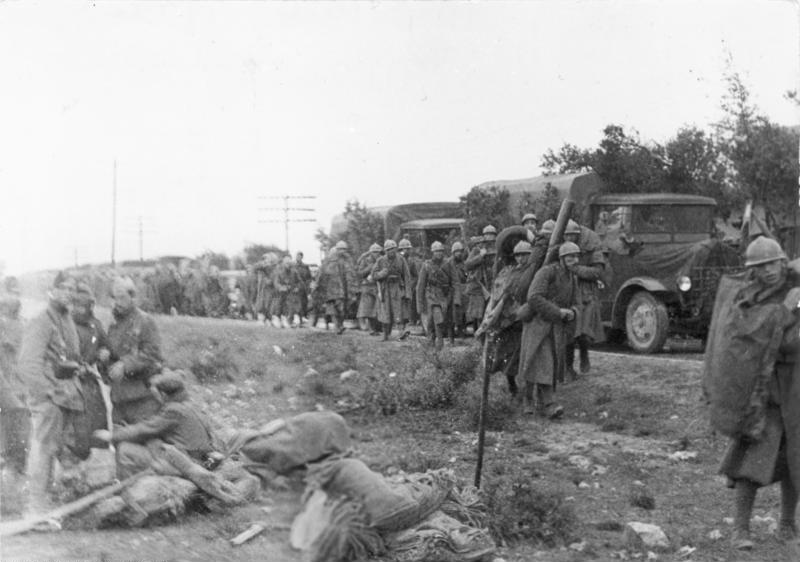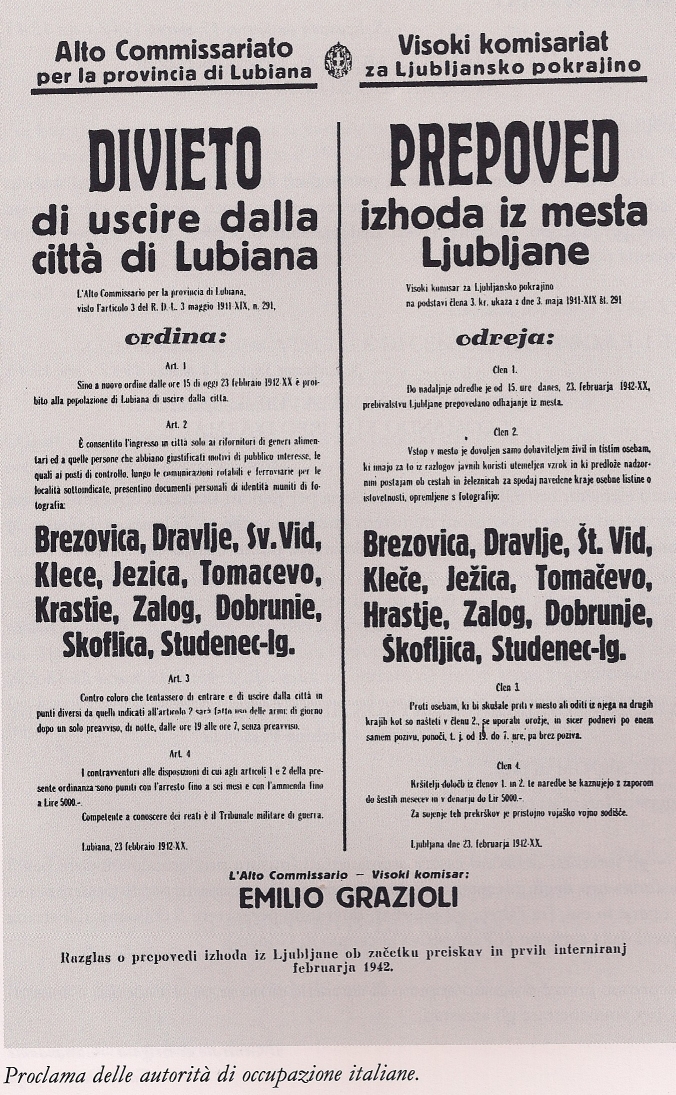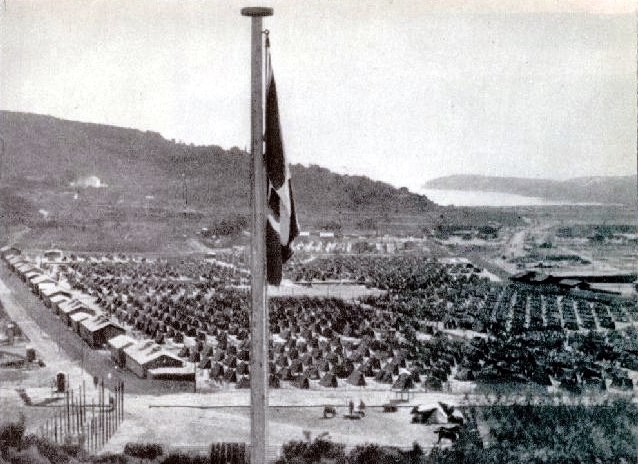|
Mario Roatta
Mario Roatta (2 February 1887 – 7 January 1968) was an Italian general. After serving in World War I he rose to command the Corpo Truppe Volontarie which assisted Francisco Franco's force during the Spanish Civil War. He was the Deputy Chief of Staff of the Italian Army from October 1939 to March 1941 and from March 1941 to January 1942 its Chief of Staff and helped in preparing for the invasion of Yugoslavia. He is best known for his role as the commander of the Italian Second Army in its repression against civilians, in the Slovene- and Croatian-inhabited areas of the Italian-occupied Yugoslavia during World War II. He constructed a policy in which he attempted to eliminate the Yugoslav Partisans, helped manage relations with the authorities of the puppet Independent State of Croatia, and "greatly advanced and systematized" collaboration with the Chetniks. As a "manifesto for repression in the Yugoslav territories", Roatta issued Circular 3C which urged "ethnic clearance ... [...More Info...] [...Related Items...] OR: [Wikipedia] [Google] [Baidu] |
Modena
Modena (, , ; egl, label= Modenese, Mòdna ; ett, Mutna; la, Mutina) is a city and '' comune'' (municipality) on the south side of the Po Valley, in the Province of Modena in the Emilia-Romagna region of northern Italy. A town, and seat of an archbishop, it is known for its car industry since the factories of the famous Italian upper-class sports car makers Ferrari, De Tomaso, Lamborghini, Pagani and Maserati are, or were, located here and all, except Lamborghini, have headquarters in the city or nearby. One of Ferrari's cars, the 360 Modena, was named after the town itself. Ferrari's production plant and Formula One team Scuderia Ferrari are based in Maranello south of the city. The University of Modena, founded in 1175 and expanded by Francesco II d'Este in 1686, focuses on economics, medicine and law, and is the second oldest athenaeum in Italy. Italian military officers are trained at the Military Academy of Modena, and partly housed in the Baroque Ducal Palace. Th ... [...More Info...] [...Related Items...] OR: [Wikipedia] [Google] [Baidu] |
Royal Italian Army (1940–1946)
This article is about the Royal Italian Army (''Regio Esercito'') which participated in the Second World War. The Royal Italian Army was reformed in 1861 and existed until 1946. The Royal Army started with the unification of Italy (''Risorgimento'') and the formation of the Kingdom of Italy (''Regno d'Italia''). It ended with the dissolution of the monarchy. The Royal Army was preceded by the individual armies of the independent Italian states and was followed by the Italian Army (''Esercito Italiano'') of the Italian Republic (''Repubblica Italiana''). Organization The Italian Army of World War II was a " Royal" army. The nominal Commander-in-Chief of the Italian Royal Army was His Majesty King Vittorio Emanuele III. As Commander-in-Chief of all Italian armed forces, Vittorio Emanuele also commanded the Royal Air Force (''Regia Aeronautica'') and the Royal Navy ('' Regia Marina''). However, in reality, most of the King's military responsibilities were assumed by the I ... [...More Info...] [...Related Items...] OR: [Wikipedia] [Google] [Baidu] |
Cuneo
Cuneo (; pms, Coni ; oc, Coni/Couni ; french: Coni ) is a city and ''comune'' in Piedmont, Northern Italy, the capital of the province of Cuneo, the fourth largest of Italy’s provinces by area. It is located at 550 metres (1,804 ft) in the south-west of Piedmont, at the confluence of the rivers Stura and Gesso. Cuneo is bounded by the municipalities of Beinette, Borgo San Dalmazzo, Boves, Busca, Caraglio, Castelletto Stura, Centallo, Cervasca, Morozzo, Peveragno, Tarantasca and Vignolo. It is located near six mountain passes: * Colle della Maddalena at * Colle di Tenda at – Tunnel of Tenda at , long * Colle del Melogno at *Colle San Bernardo at * Colle di Nava at *Colle di Cadibona at . History Cuneo was founded in 1198 by the local population, who declared it an independent commune, freeing themselves from the authority of the bishops of Asti and the marquisses of Montferrat and Saluzzo. In 1210, the latter occupied it, and in 1231 the '' ... [...More Info...] [...Related Items...] OR: [Wikipedia] [Google] [Baidu] |
Province Of Ljubljana
The Province of Ljubljana ( it, Provincia di Lubiana, sl, Ljubljanska pokrajina, german: Provinz Laibach) was the central-southern area of Slovenia. In 1941, it was annexed by Fascist Italy, and after 1943 occupied by Nazi Germany. Created on May 3, 1941, it was abolished on May 9, 1945, when the Slovene Partisans and partisans from other parts of Yugoslavia liberated it from the Nazi Operational Zone of the Adriatic Littoral. Its administrative centre was Ljubljana. Background During World War II, Drava Banovina was in a unique situation. While Greece shared its experience of being trisected, this territory (roughly present-day Slovenia) experienced a further step—absorption and annexation into neighboring Nazi Germany, Fascist Italy, and Hungary.Gregor Joseph Kranjc (2013To Walk with the Devil University of Toronto Press, Scholarly Publishing Division, p. introduction 5 After Yugoslavia was invaded by Axis Powers on 6 April 1941, Germany and Hungary occupied and annexed the ... [...More Info...] [...Related Items...] OR: [Wikipedia] [Google] [Baidu] |
Gonars Concentration Camp
The Gonars concentration camp was one of the several Italian concentration camps and it was established on February 23, 1942, near Gonars, Italy. Many internees were transferred to this camp from the other Italian concentration camp, Rab concentration camp, which served as equivalent of final solution in Mario Roatta's ethnic cleansing policy against ethnic Slovenes from the Italian-occupied Province of Ljubljana and Croats from Gorski Kotar, in accord with the racist 1920s speech by Benito Mussolini, along with other Italian war crimes committed on the Italian-occupied territories of Yugoslavia: The first transport of 5,343 internees (1,643 of whom were children) arrived two days after its establishment, on February 23, 1942, from the Province of Ljubljana and from the other two Italian concentration camps, the Rab camp and the camp in Monigo (near Treviso). The camp was disbanded on September 8, 1943, immediately after the Italian armistice. Only in 1973 a sacrarium ... [...More Info...] [...Related Items...] OR: [Wikipedia] [Google] [Baidu] |
Rab Concentration Camp
The Rab concentration camp ( it, Campo di concentramento per internati civili di Guerra – Arbe; hr, Koncentracijski logor Rab; sl, Koncentracijsko taborišče Rab) was one of several Italian concentration camps. It was established during World War II, in July 1942, on the Italian-occupied island of Rab (now in Croatia). According to historians James WalstonJames Walston (1997History and Memory of the Italian Concentration Camps ''Historical Journal'', p. 40. and Carlo Spartaco Capogeco,Cresciani, Gianfranco (2004Clash of civilisations, Italian Historical Society Journal, Vol.12, No.2, p.7 at 18%, the annual mortality rate in the camp was higher than the average mortality rate in the Nazi concentration camp of Buchenwald (15%). According to a report by Monsignor Jože Srebrnič, Bishop of Krk on 5 August 1943 to Pope Pius XII: "witnesses, who took part in the burials, state unequivocally that the number of the dead totals at least 3,500". According to Yugoslav estimates of the ... [...More Info...] [...Related Items...] OR: [Wikipedia] [Google] [Baidu] |
Italian Concentration Camps
Italian concentration camps include camps from the Italian colonial wars in Africa as well as camps for the civilian population from areas occupied by Italy during World War II. Memory of both camps were subjected to "historical amnesia". The repression of memory led to historical revisionism in ItalyAlessandra Kersevan 2008: (Editor) Foibe – Revisionismo di stato e amnesie della repubblica. Kappa Vu. Udine. and in 2003 the Italian media published Silvio Berlusconi's statement that Benito Mussolini only "used to send people on vacation".''Survivors of war camp lament Italy's amnesia'' , 2003, International Herald Tribune Colonial wars There were numerous w ...[...More Info...] [...Related Items...] OR: [Wikipedia] [Google] [Baidu] |
Summary Execution
A summary execution is an execution in which a person is accused of a crime and immediately killed without the benefit of a full and fair trial. Executions as the result of summary justice (such as a drumhead court-martial) are sometimes included, but the term generally refers to capture, accusation, and execution all conducted within a very short period of time, and without any trial. Under international law, refusal to accept lawful surrender in combat and instead killing the person surrendering is also categorized as a summary execution (as well as murder). Summary executions have been practiced by police, military, and paramilitary organizations and are frequently associated with guerrilla warfare, counter-insurgency, terrorism, and any other situation which involves a breakdown of the normal procedures for handling accused prisoners, civilian or military. Civilian jurisdiction In nearly all civilian jurisdictions, summary execution is illegal, as it violates the r ... [...More Info...] [...Related Items...] OR: [Wikipedia] [Google] [Baidu] |
Chetniks
The Chetniks ( sh-Cyrl-Latn, Четници, Četnici, ; sl, Četniki), formally the Chetnik Detachments of the Yugoslav Army, and also the Yugoslav Army in the Homeland and the Ravna Gora Movement, was a Kingdom of Yugoslavia, Yugoslav royalist and Serbian nationalist movement and Guerrilla warfare, guerrilla force in Axis powers, Axis-occupied Yugoslavia. Although it was not a homogeneous movement, it was led by Draža Mihailović. While it was anti-Axis in its long-term goals and engaged in marginal resistance activities for limited periods, it also engaged in tactical or selective Collaborationism, collaboration with the occupying forces for almost all of the war. The Chetnik movement adopted a policy of collaboration with regard to the Axis, and engaged in cooperation to one degree or another by establishing ''modus vivendi'' or operating as "legalised" auxiliary forces under Axis control. Over a period of time, and in different parts of the country, the movement was progre ... [...More Info...] [...Related Items...] OR: [Wikipedia] [Google] [Baidu] |
Independent State Of Croatia
The Independent State of Croatia ( sh, Nezavisna Država Hrvatska, NDH; german: Unabhängiger Staat Kroatien; it, Stato indipendente di Croazia) was a World War II-era puppet state of Nazi Germany and Fascist Italy. It was established in parts of occupied Yugoslavia on 10 April 1941, after the invasion by the Axis powers. Its territory consisted of most of modern-day Croatia and Bosnia and Herzegovina, as well as some parts of modern-day Serbia and Slovenia, but also excluded many Croat-populated areas in Dalmatia (until late 1943), Istria, and Međimurje regions (which today are part of Croatia). During its entire existence, the NDH was governed as a one-party state by the fascist Ustaša organization. The Ustaše was led by the ''Poglavnik'', Ante Pavelić."''Poglavnik''" was a term coined by the Ustaše, and it was originally used as the title for the leader of the movement. In 1941 it was institutionalized in the NDH as the title of first the Prime Minister (1941–1 ... [...More Info...] [...Related Items...] OR: [Wikipedia] [Google] [Baidu] |
Yugoslav Partisans
The Yugoslav Partisans,Serbo-Croatian, Macedonian, Slovene: , or the National Liberation Army, sh-Latn-Cyrl, Narodnooslobodilačka vojska (NOV), Народноослободилачка војска (НОВ); mk, Народноослободителна војска (НОВ); sl, Narodnoosvobodilna vojska (NOV) officially the National Liberation Army and Partisan Detachments of Yugoslavia, sh-Latn-Cyrl, Narodnooslobodilačka vojska i partizanski odredi Jugoslavije (NOV i POJ), Народноослободилачка војска и партизански одреди Југославије (НОВ и ПОЈ); mk, Народноослободителна војска и партизански одреди на Југославија (НОВ и ПОЈ); sl, Narodnoosvobodilna vojska in partizanski odredi Jugoslavije (NOV in POJ) was the communist-led anti-fascist resistance to the Axis powers (chiefly Germany) in occupied Yugoslavia during World War II. Led by Josip Broz ... [...More Info...] [...Related Items...] OR: [Wikipedia] [Google] [Baidu] |
Occupied Yugoslavia
World War II in the Kingdom of Yugoslavia began on 6 April 1941, when the country was swiftly conquered by Axis forces and partitioned between Germany, Italy, Hungary, Bulgaria and their client regimes. Shortly after Germany attacked the USSR on 22 June 1941, the communist-led republican Yugoslav Partisans, on orders from Moscow, launched a guerrilla liberation war fighting against the Axis forces and their locally established puppet regimes, including the Axis-allied Independent State of Croatia (NDH) and the Government of National Salvation in the German-occupied territory of Serbia. This was dubbed the National Liberation War and Socialist Revolution in post-war Yugoslav communist historiography. Simultaneously, a multi-side civil war was waged between the Yugoslav communist Partisans, the Serbian royalist Chetniks, the Axis-allied Croatian Ustaše and Home Guard, Serbian Volunteer Corps and State Guard, Slovene Home Guard, as well as Nazi-allied Russian Protective Co ... [...More Info...] [...Related Items...] OR: [Wikipedia] [Google] [Baidu] |


.jpg)



